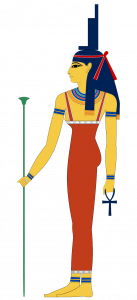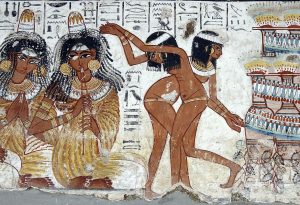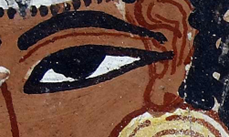Part II of a Cognitive Science Series
Cleopatra. We know her as the last pharaoh of Egypt, a fierce political leader, and a woman whose beauty became legendary. But what if I told you Cleopatra wasn’t just a queen with incredible charisma—she was also one of the greatest cosmetologists of all time? Yes, the Cleopatra we read about in history books might just be the original beauty icon who understood the science behind looking fabulous. And I’m not just talking about a little eyeliner. We’re diving into the fascinating world of ancient makeup, and how Cleopatra used it to her advantage—both in beauty and power.

Cleopatra, on a coin minted at Alexandria*
Beauty, Power, and Science
So, why talk about Cleopatra’s beauty routine? For one, it wasn’t just vanity. Cleopatra understood the power of appearances. In a world dominated by men, especially men like Julius Caesar and Marc Antony, Cleopatra knew that looking the part of a goddess wasn’t optional—it was essential. Her use of makeup wasn’t just to dazzle; it was strategic. Cleopatra embodied the goddess Isis, and her cosmetology wasn’t just about looking good, but about aligning herself with divine authority.
Isis
The Origins of Cosmetology
Let’s break it down. The word “cosmetology” has its roots in the Greek term kosmētikos, meaning “skilled in adornment.” The suffix “-ology” means the study of something, like biology (study of life) or psychology (study of the mind). So, Cleopatra’s interest in makeup wasn’t just about experimenting with new eyeliner—it was about mastering the art and science of adornment. But here’s the kicker: Cleopatra actually wrote a book on cosmetology!** Unfortunately, it was lost when the Library of Alexandria burned down. Imagine the beauty tips we could’ve gotten from Cleopatra herself.Cleopatra’s Signature Look: Kohl & Malachite
One of Cleopatra’s most iconic looks was her bold, dramatic eye makeup, specifically kohl and malachite. Kohl was made from galena, a lead-based mineral, which Egyptians believed had protective properties against infections. Cleopatra wasn’t just painting her eyes to look glamorous; she was using a cosmetic that could prevent eye diseases. And let’s be real: walking around in the Egyptian heat, you’d probably want that, too. The black kohl that rimmed her eyes not only added drama but reflected the power of the goddess Isis, whose image Cleopatra often adopted. But Cleopatra didn’t stop at black. She also used green malachite on her eyes, a pigment meant to evoke the eye of Horus—a symbol of protection, health, and power.
Depiction of musicians and dancers wearing kohl
The Science of the Eye of Horus
Speaking of Horus, let’s take a closer look at the significance of this symbol. The Eye of Horus was more than just a pretty eye; it was deeply rooted in Egyptian culture and mythology. Horus, the falcon-headed god, lost his eye in a battle with his uncle Set. The symbol became a representation of protection and restoration. But here’s where it gets really interesting: the proportions of the Eye of Horus actually reflect the golden ratio, a mathematical formula often seen in nature and art. Cleopatra, being highly educated, almost certainly knew about the golden ratio and its significance. By using makeup to replicate the proportions of the Eye of Horus on her own face, she wasn’t just creating a look—she was embodying divine beauty in a way that resonated with her people and solidified her power.
Eye of Horus, reflecting Golden Ratio proportions
Beyond Beauty: Political Power Through Cosmetology
Now, let’s get one thing straight. Cleopatra wasn’t just about looking good for Marc Antony and Julius Caesar. She was an intelligent and strategic leader, and her knowledge of beauty was deeply intertwined with her political ambitions. Historians like Plutarch described her ability to charm and captivate through her appearance as nothing short of magical. Some accounts even labeled her as a “witch”—but what they were really witnessing was Cleopatra’s profound understanding of the psychology of beauty. In a world where men held the reins of power, Cleopatra used every tool at her disposal to assert her influence. By adorning herself as the goddess Isis, she blurred the lines between mortal and divine, between queen and deity. When Cleopatra appeared in full Isis regalia, she was not just showing off her beauty—she was sending a powerful message: that she was a ruler destined by the gods.The Hidden Science Behind Cleopatra’s Makeup
Cleopatra’s use of makeup wasn’t just about aesthetic beauty—it was about control. Think about it. Modern makeup enhances features, but Cleopatra’s makeup often covered parts of her eyes, like the lacrimal caruncle (that small pinkish bump in the corner of your eye). By obscuring these features, Cleopatra was controlling how people perceived her. It’s possible that this strategic covering up made her appear more alluring and less “human,” which, let’s be real, was probably the point. In modern terms, it’s a bit like how sunglasses make people look effortlessly cool and mysterious. We can’t see their eyes fully, so we fill in the blanks, often assuming something “better” than reality. Cleopatra was essentially doing the same thing, only with kohl and malachite instead of Ray-Bans.
Closeup of applied kohl
Cleopatra’s Legacy: The Original Beauty Influencer
So, why does Cleopatra’s approach to beauty still matter today? For one, she showed us that beauty and intelligence aren’t mutually exclusive. Cleopatra knew that her appearance was part of her power, and she wasn’t afraid to use it to her advantage. She understood the psychological and even mathematical aspects of beauty in a way that’s still relevant today. In an era where women often feel pressure to conform to certain beauty standards, Cleopatra’s legacy is a reminder that beauty can be a tool of empowerment. Whether you’re swiping on eyeliner or carefully crafting your personal brand, Cleopatra’s influence shows us that the power of adornment goes deeper than just looks—it’s about crafting how the world sees you. So next time you reach for that eyeliner, think of Cleopatra and the centuries of knowledge and strategy behind every stroke. You might just be tapping into something far more powerful than you realize.
Eye of Horus
Final Thoughts
Cleopatra wasn’t just a historical figure; she was a force. From her mastery of languages to her profound understanding of beauty and power, Cleopatra’s legacy transcends time. She wasn’t afraid to use her looks strategically, and that’s something we can all take a lesson from. In a world where appearances still matter, Cleopatra reminds us that looking good and being smart aren’t just compatible—they’re unstoppable when used together.Notes:
*Source of all images is Wikipedia.org
**Facts about the life of Cleopatra in this blog post are taken from Stacy Schiff’s Cleopatra: A Life (2010).
Be sure to check out the next installment of this series.
Be sure to check out this experiential web app, leveraging the principles within this blog post and beyond!
